Elephanta caves - UNESCO World heritage site
Elephanta caves are network of sculpted caves off the coast of Mumbai in Arabian sea. Its 10kms from Gateway of India and takes approx 45minutes by ferry ride. The caves architecture dates back from 5th to 8th century. The total of 7 caves are UNESCO WORLD HERITAGE SITE divided into 2 sections, 5 larger ones devoted to Lord Shiva and 2 smaller ones are devoted to Lord Buddha.
These caves are architectural marvel and heritage that every Mumbaites is proud of. The island earlier called as Gharapuri in local language but during the Portuguese rule, It was named as Elephanta after finding a rock cut elephant sculpture which is now placed at Bhau daji lad museum at Byculla.
The island has two hills called Stupa hills with thick forest cover on them. There are three small hamlets or small villages of fisherman folks on three different corners of the island but being strategically located off the coast of Mumbai, Its also a part of restricted area which comes under Indian Navy. The island is quiet and picturesque with monkeys scammering around. The forest cover is also home to migratory birds and breeding ground for eagles.
The one hour ride from Gateway of India is quite an experience as we can see the Mumbai shoreline and also huge merchant ships and tankers anchored off the coast of Mumbai in the middle of Arabian sea.


From September to March, different parts of Mumbai becomes home to migratory birds. Elephanta island is one such area which is home to migratory birds due to protected forest cover on the island.
The island is nesting ground for eagles which are common on the island. While Seagulls are common site when travelling in ferry to Elephanta island. Amazing to see these birds following the ferry boats and also fishing in the Arabian sea.





The Elephanta caves complex is collection of shrines, courtyards,inner cells, grand halls arranged in symmetry of Indian rock cut architecture and filled with exquisite stone sculptures of Lord Shiva and other Hindu gods and goddess. The sculptures in the main cave which is also called Shiva cave depict different form of Shiva like "Nataraja- the dance form of Shiva" "Yogishvara - lord of Yoga" "Ardhanarisvara - half man, half woman representation of Shiva".



The main cave also has Shiva Lingam in a cave with all four sides having a door on all four corners. But this is not a temple of worship as temple needs to have a "DHAJA" or a orange flag at the top of the temple complex.

The main cave also has a very prominent carving of "TRIMURTI" described as master piece, the most important sculpture in the cave complex.

The 20ft three headed Shiva represents three essential aspect of Shiva - CREATION, PROTECTION, DESTRUCTION.
The cave also has carvings depicting Shiva slaying the demon Andhaka and Shiva's marriage to Parvati.

The main cave complex which consist of 3 large caves as seen from the top of the hill.



The caves 3, 4, 5 are smaller caves as compared to main caves 1 & 2. Also as per the tour guides and experts on Elephanta caves mentions that these smaller caves were abandoned due to the not so solid nature of the rock and also because the rain water gets accumulated in these caves during the monsoon season and caves are submerged under water for almost 3-4 months of monsoon season.

Apart from the caves, the other attractions on the island includes two canon's at the top of the hill which indicates the strategic location of the island just outside Mumbai. Also a man made pond for water conservation and to supply water to near by hamlets and the Navy installations nearby.

The jetty as seen from the top of Stupa hill.
The road leading to the canon's at the top of the hill passes through thick cover of forest and also gives a 360 degree view of the island.






The toy train which ferries passengers from the jetty to the main entrance of the cave is a joy ride worth taking and cost Rs 10/- for a return journey.
PICS FROM MY CLICKS ON THE RETURN JOURNEY FROM THE ISLAND.


These caves are architectural marvel and heritage that every Mumbaites is proud of. The island earlier called as Gharapuri in local language but during the Portuguese rule, It was named as Elephanta after finding a rock cut elephant sculpture which is now placed at Bhau daji lad museum at Byculla.
The island has two hills called Stupa hills with thick forest cover on them. There are three small hamlets or small villages of fisherman folks on three different corners of the island but being strategically located off the coast of Mumbai, Its also a part of restricted area which comes under Indian Navy. The island is quiet and picturesque with monkeys scammering around. The forest cover is also home to migratory birds and breeding ground for eagles.
The one hour ride from Gateway of India is quite an experience as we can see the Mumbai shoreline and also huge merchant ships and tankers anchored off the coast of Mumbai in the middle of Arabian sea.


From September to March, different parts of Mumbai becomes home to migratory birds. Elephanta island is one such area which is home to migratory birds due to protected forest cover on the island.
The island is nesting ground for eagles which are common on the island. While Seagulls are common site when travelling in ferry to Elephanta island. Amazing to see these birds following the ferry boats and also fishing in the Arabian sea.


 |
| Seagulls at Mumbai Harbour |


 |
| Nesting ground for Eagles |

The Elephanta caves complex is collection of shrines, courtyards,inner cells, grand halls arranged in symmetry of Indian rock cut architecture and filled with exquisite stone sculptures of Lord Shiva and other Hindu gods and goddess. The sculptures in the main cave which is also called Shiva cave depict different form of Shiva like "Nataraja- the dance form of Shiva" "Yogishvara - lord of Yoga" "Ardhanarisvara - half man, half woman representation of Shiva".



The main cave also has Shiva Lingam in a cave with all four sides having a door on all four corners. But this is not a temple of worship as temple needs to have a "DHAJA" or a orange flag at the top of the temple complex.

The main cave also has a very prominent carving of "TRIMURTI" described as master piece, the most important sculpture in the cave complex.

The 20ft three headed Shiva represents three essential aspect of Shiva - CREATION, PROTECTION, DESTRUCTION.
The cave also has carvings depicting Shiva slaying the demon Andhaka and Shiva's marriage to Parvati.

The main cave complex which consist of 3 large caves as seen from the top of the hill.



The caves 3, 4, 5 are smaller caves as compared to main caves 1 & 2. Also as per the tour guides and experts on Elephanta caves mentions that these smaller caves were abandoned due to the not so solid nature of the rock and also because the rain water gets accumulated in these caves during the monsoon season and caves are submerged under water for almost 3-4 months of monsoon season.

Apart from the caves, the other attractions on the island includes two canon's at the top of the hill which indicates the strategic location of the island just outside Mumbai. Also a man made pond for water conservation and to supply water to near by hamlets and the Navy installations nearby.

The jetty as seen from the top of Stupa hill.
The road leading to the canon's at the top of the hill passes through thick cover of forest and also gives a 360 degree view of the island.






The toy train which ferries passengers from the jetty to the main entrance of the cave is a joy ride worth taking and cost Rs 10/- for a return journey.
PICS FROM MY CLICKS ON THE RETURN JOURNEY FROM THE ISLAND.












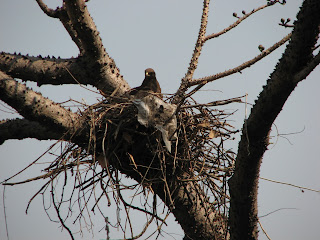



















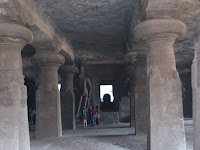

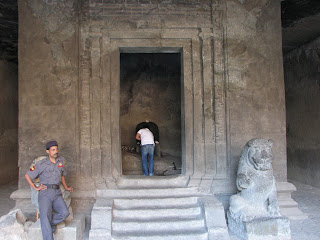














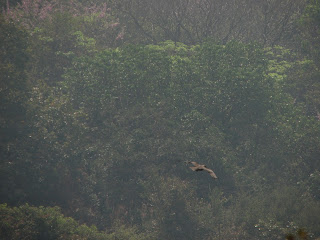









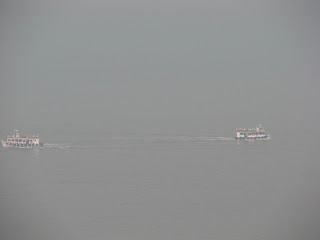




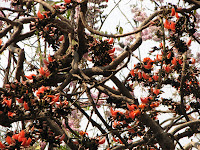








Comments
Post a Comment